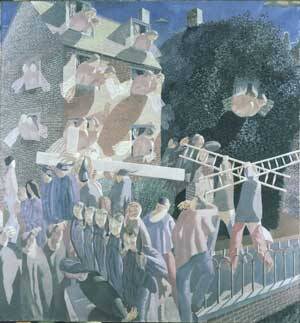When St. Paul writes to the Galatians about the world having been crucified to him and he to the world (6:14), he is speaking of his death to all that is opposed to God. His life, by contrast, comes from faith and baptism in the paschal mystery of Christ. Apart from Georges Rouault, no artist of the 20th century seems to have experienced this confession, and indeed the whole Christian story, as so closely following the patterns of his own life as Stanley Spencer (1891-1959).
Born at Cookham on Thames, Berkshire, as the youngest of eight children, Spencer was educated at home in Fernlea, the house his grandfather had built in Cookham. There he experienced a kind of Edenic childhood. Having commuted daily to London to study at the Slade School from 1908 to 1912, he set most of his notable early pictures, which had religious themes, in Cookham and its surrounding landscape.
The serenity and even sanctity he found there were ruptured when he enlisted in the Royal Army Medical Corps in 1915 and was posted to Macedonia. He returned home only in December 1918. The rest of his life would be a search for his former sense of wholeness, “a project of remembrance and reconstruction,” as one critic has put it. In his painting “Christ Carrying the Cross” (1920), we find a major statement of that theme.
With his mother’s grief at his departure for the war still haunting his soul, Spencer shows a determined Christ (with the profile of his father), accompanied by four soldiers in winged helmets, just as he passes Fernlea, with its adjacent ivy-covered cottage, The Nest, to the right. Behind the cross, two workers carry ladders that will be used to raise it. (They form a St. Andrew’s cross.) In the lower left corner, “Ma” has been metamorphosed into the grieving Mary. Through a fence that seems made of spears, she is observed by five white-faced, agonized men who represent at once Stanley and the five Spencer sons gone to war.
A throng of figures (the artist’s family and friends) peers at the spectacle from Fernlea and The Nest; they are given angels’ wings by the lace curtains that blow out of the windows on the warm summer afternoon. (Residents of Cookham would recognize the low July sun casting the light of evening.) With its pale, chalky color harmonies, flattened figures and distorted space, the painting recalls the Italian primitives Spencer had loved as a young man. The scene is at once ordinary and mysterious, realistic and visionary, a tableau of deep emotion from which the viewer is nevertheless distanced. (The trio of young men in the bottom center represents Stanley and two friends as onlookers, not participants.)
Spencer’s career went through significant reversals and revivals after the celebrated postwar paintings of the 1920s. “The Resurrection, Cookham” of 1924-27, largely a celebration of the sexuality he discovered through his marriage to Hilda Carlin, and his “Sandham Memorial Chapel at Burghclere” of 1930-32 were particular successes. Involved in marital difficulties and an obsession with a fellow artist, Patricia Preece, in the later 1930s, Spencer experienced a restoration of his finances and reputation through his monumental series, “Shipbuilding on the Clyde.” In 1955 he enjoyed a major retrospective at the Tate Britain.
In this Lenten season, “Christ Carrying the Cross” may seem to transcend its origin and time. Spencer’s biographer, Kenneth Pople, wrote that the cross “represented for Stanley, as he assumed it represented for all, a necessary submission to the perpetual confusions and frustrations of existence from which it is our purpose to seek redemptive meaning.” What Christian does not sometimes reduce Calvary to a conundrum or to something we may accept but despair of ever understanding?
But what if we take these words of Jesus not as an obscure vision but as a redeeming reality: “If any man would come after me, let him deny himself and take up his cross and follow me” (Mk 8:34)? What if the sorrows and agonies of life are not simply challenges we must accept and ascribe to the all-encompassing mercy of the Crucified? What if we are meant not simply to accept our redeemed mortality, but dimly to discern that in all suffering we are truly one with our wounded Lord? All those wounds, our own and those far more fearful ones borne by other members of the human family, echo the depths of a humanity that the incarnate and crucified Word shared with us—and shares still.
In Lent, approaching once more the celebration of our paschal mystery, we journey not simply toward acceptance of what is unintelligible on human terms. We journey with Jesus toward Absolute Acceptance itself, which invites us into acceptance, the Father of Jesus whose Spirit sings daily to each and all of us: “Yes, here is my love. Take it. It is yours.”








